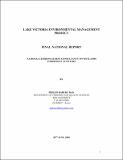| dc.description.abstract | This report presents a critical review of activities carried out by LVEMP Wetlands
Component in the last seven years of the project with a view of coming up with
lessons learnt form interventions implemented in the entire basin. The thirty-day
exercise was based on both primary and secondary data. Various methodologies were
used to collect information from project implementers, beneficiaries and other
relevant stakeholders including structured and unstructured interviews. Desk review
was also carried out on reports accumulated by the wetlands component, literature
from libraries of research institutions, universities, government departments and local
and international NGO’s. Field visits were made to selected sites where randomly
selected beneficiaries were interviewed and investments inspected. Some information
was also obtained through direct observation, workshops and informal interviews.
Findings show that the component used appropriate methodologies like PRA’s to find
an entry point into the communities. Rapid assessments, inventories and market
surveys were also conducted to identify and prioritize activities that would best
answer problems faced by the community and the wetland resources. In some cases,
the beneficiaries were adequately exposed by sponsoring them to various exhibitions
and exchange visits. Membership of all the groups was relatively low, some with no experience in the
implementation of such projects which compromised their performance. Supervision
and intensity of extension services and training were the major contributing factor in
the performance of the group. Most of the activities in the buffering capacity subcomponent
were performed by a consulting firm. The study contributed very well to
our understanding of the buffering role of wetlands in the upper catchment. A gap
however, still remains on the role played by the littoral lakeshore wetlands.
The overall achievement of the objectives by the component is satisfactory. This is
attributed to numerous constraints including the fact that wetland management is a
relatively new area and most concepts not easily grasped by a cross section of
stakeholders. Others include staffing problems, inadequacy and poor flow of funds,
lack of policy framework, inadequate networking and sharing of resources among
components.Survey of other institutions within the basin involved in wetlands research,
conservation and management revealed the existence of enormous information which
could augment the work being done by the component. Establishment of institutional
linkages is recommended to help the component exploit the information and benefit
from human resource in wetlands and related disciplines. Among the lessons learnt over the project lifetime includes the importance of using
appropriate tools and involving the local communities right from the beginning of the projects. The need to emphasize wise use of wetlands, and the immense potential in
the use of wetlands and their products to reduce poverty, increase food security and
improve standards of living of local communities. Significance of the buffering role of
wetlands and the need to integrate wetland conservation issues with provision of
alternative livelihoods if we have to protect our wetlands. | en_US |

